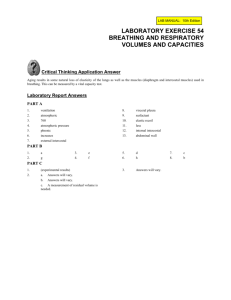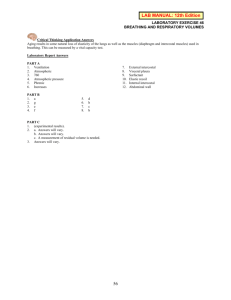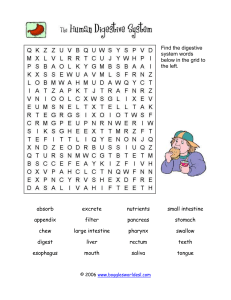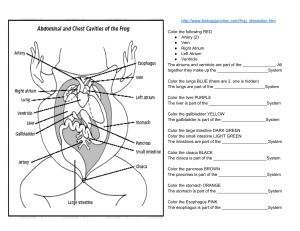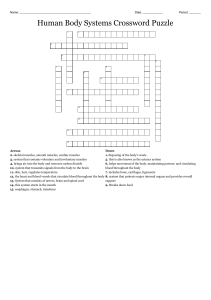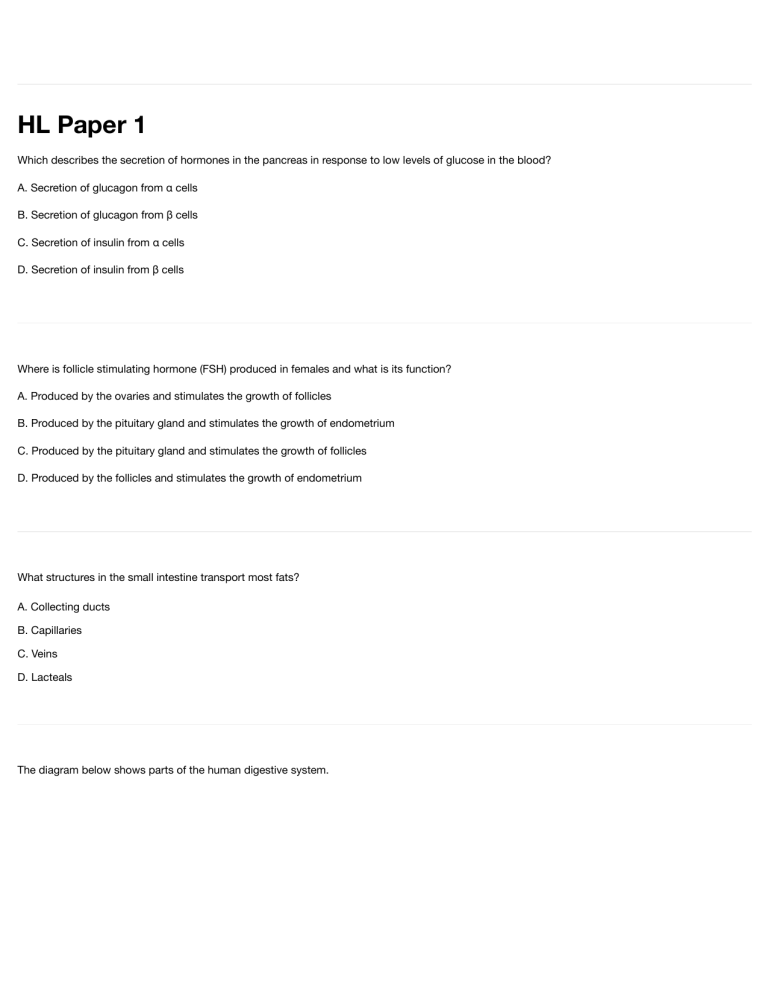
HL Paper 1 Which describes the secretion of hormones in the pancreas in response to low levels of glucose in the blood? A. Secretion of glucagon from α cells B. Secretion of glucagon from β cells C. Secretion of insulin from α cells D. Secretion of insulin from β cells Where is follicle stimulating hormone (FSH) produced in females and what is its function? A. Produced by the ovaries and stimulates the growth of follicles B. Produced by the pituitary gland and stimulates the growth of endometrium C. Produced by the pituitary gland and stimulates the growth of follicles D. Produced by the follicles and stimulates the growth of endometrium What structures in the small intestine transport most fats? A. Collecting ducts B. Capillaries C. Veins D. Lacteals The diagram below shows parts of the human digestive system. Which points are linked by the small intestine? A. I and III B. II and III C. II and IV D. III and IV The graph shows the ventilation rate and the oxygen consumption of a subject before, during and after a period of exercise. Which could be a reason for the oxygen consumption to remain high for some time after the end of the period of exercise? A. Epinephrine keeps the ventilation rate high. B. Part of the exercise was done using anaerobic respiration. C. A low ventilation rate keeps the consumption high. D. More ATP is necessary for cross bridge formation while muscles cool down. During the menstrual cycle, what occurs in response to a fall in the progesterone level? A. Growth of the uterus lining B. Growth of the follicle surrounding the egg C. Ovulation D. Menstruation Glucose is absorbed through protein channels in the plasma membrane of epithelium cells in the small intestine. Which characteristics of glucose prevent its diffusion through the phospholipid bilayer? A. It is non-polar and therefore hydrophobic. B. Its hydrogen bonds link with amino acids in the protein channel. C. It is polar and therefore hydrophilic. D. Its covalent bonds interact with the phospholipids. Which structure releases glucagon? A. α cells of the pancreas B. β cells of the pancreas C. Liver cells D. Hypothalamus What are features of the enzyme amylase? Which enzyme is amylase? What is the role of the pacemaker (SAN)? A. It controls the release of epinephrine (adrenaline). B. It sends nerve impulses to the ventricles. C. It regulates the activity of the medulla. D. It changes the frequency of muscle contraction in the heart. Formation of a blood clot by damaged tissue involves the series of steps outlined in the following diagram. Which letter represents a soluble globular protein that will be converted into an insoluble protein during clot formation? If schizophrenia is caused by an overabundance of the neurotransmitters dopamine and serotonin in the synapses of some areas of the brain, which drug action could work in treating the symptoms? A. Release of cholinesterase into the synaptic cleft B. Increased re-uptake of dopamine and serotonin by presynaptic neurons C. Increased permeability of the presynaptic neuron to sodium D. Blockage of dopamine and serotonin receptors on presynaptic neurons Why are antibiotics effective against bacteria but not viruses? A. Viruses can hide inside host cells. B. Bacteria are recognized as pathogens but viruses are not. C. The enzymes of bacteria can be inhibited by antibiotics. D. Viruses are resistant to antibiotics. What causes the rate of heart contraction to increase or decrease? A. The heart muscle itself B. Nerve impulses from the brain C. A hormone from the thyroid gland D. The rate of return of blood to the left atrium Which of the following parts of the digestive system secrete proteases? What is a characteristic of axons in motor neurons? A. When there is a resting potential, the outside of the axon is negative relative to the inside. B. During an action potential, Na+ ions diffuse out of the axon. C. K+ ions diffusing out of the axon repolarizes it. D. Impulses in the axon travel towards the cell body. What are functions of the stomach, small intestine and large intestine? Which reaction during blood clotting is catalysed by the enzyme thrombin? A. Soluble fibrin to fibrous fibrinogen B. Soluble fibrinogen to fibrous fibrin C. Fibrous fibrinogen to soluble fibrin D. Fibrous fibrin to soluble fibrinogen What is a feature of type I diabetes but not type II diabetes? A. Target cells become insensitive to insulin. B. β cells do not produce sufficient insulin. C. Type I diabetes can be controlled through a low carbohydrate diet. D. α cells produce excess insulin. Which response takes place when blood glucose levels are low? A. Glucagon is released from the α cells of the pancreatic islets. B. Glucagon is released from the β cells of the pancreatic islets. C. Insulin is released from the α cells of the pancreatic islets. D. Insulin is released from the β cells of the pancreatic islets. Which discovery was an indication that the heart pumps blood to the body through arteries? A. The amount of blood pumped exceeds that of blood produced B. Blood could easily be pushed up a limb vein, but not down C. The observation that there were pores between the right and left atria D. The heart swelled up when the arteries were tied in an animal experiment Which blood vessel directly supplies oxygen to the heart muscle? A. Aorta B. Coronary artery C. Pulmonary artery D. Pulmonary vein The concentration of which hormone peaks sharply triggering ovulation? A. FSH B. LH C. Estrogen D. Progesterone What is a long-term effect of HIV on the immune system? A. Increase in leucocytes B. Reduction in erythrocytes C. Increase in antibody production D. Reduction in active lymphocytes Where is absorption of digested food carried out? I. Villi II. Pancreas III. Small intestine A. I only B. I and II only C. I and III only D. I, II and III A process occurs in which the inside of a neuron develops a net positive charge compared with the outside. What is the name of this process? A. Resting potential B. Repolarization C. Depolarization D. Hyperpolarization What causes heart ventricles to fill with blood? I. Atrial contraction II. Closing of atrio-ventricular valves III. Opening of semilunar valves A. I only B. I and II only C. II and III only D. III only Which is the correct statement concerning HIV and AIDS? A. All HIV patients have AIDS. B. HIV and AIDS are transmitted on the sex chromosomes. C. All AIDS patients have HIV. D. HIV and AIDS neutralize antibodies. What is the consequence of insufficient secretion of FSH in women? A. Embryo implantation fails because the uterus lining is too thin. B. Mature eggs (oocytes) are not produced. C. Menstruation starts before embryo implantation occurs. D. Progesterone secretion is inhibited. Where does the digestion of polypeptides start in humans? A. Mouth B. Esophagus C. Stomach D. Small intestine What are the conditions of the blood travelling through the pulmonary vein? What will be happening in a person after eight hours of sleep? A. β cells in the pancreas will be producing insulin. B. Glucose will be converted into glucagon. C. α cells in the pancreas will be producing glucagon. D. Glycogen is being produced and stored in the liver and muscle cells. What is the mechanism of sodium-potassium pumps in neurons that generates a resting potential by active transport? A. K+ from cytoplasm binds to the pump and stimulates its phosphorylation by ATP. B. Phosphorylation of the pump causes its shape change in order to move Na+ into the cytoplasm. C. K+ from inside the cell binds to the pump and causes the release of the phosphate group. D. Na+ from cytoplasm binds to the pump and stimulates its phosphorylation by ATP. Which hormone shows the greatest fall in blood concentration just before menstruation? A. FSH (follicle stimulating hormone) B. LH (luteinizing hormone) C. Progesterone D. Estrogen Is the blood in the aorta, left ventricle and pulmonary artery oxygenated or deoxygenated? What are antibodies? A. Organisms or viruses that cause disease B. Drugs used to treat bacterial diseases C. Substances the body recognizes as foreign D. Proteins that bind to foreign substances What steps occur in blood clotting? A. Fibrin is converted to fibrinogen which then alters prothrombin into thrombin. B. Thrombin is converted to prothrombin which then alters fibrinogen into fibrin. C. Fibrinogen is converted to fibrin which then alters prothrombin into thrombin. D. Prothrombin is converted to thrombin which then alters fibrinogen into fibrin. What happens first when a neurotransmitter binds to a postsynaptic neuron? A. Ions diffuse B. Electrophoresis begins C. Ca2+ channels open D. Repolarization Celiac disease causes the destruction of the villi cells. Which of the following is most likely to happen to people with celiac disease? A. Incomplete digestion of fats B. Poor absorption of calcium C. Increased levels of glucose in blood D. Damage in the esophagus caused by increase in acid content of the stomach What is the condition of the valves of the heart when the right ventricle is contracting? What muscle actions cause air to be expelled from the lungs? A. Internal intercostal muscles relax and diaphragm contracts B. External intercostal muscles contract and abdominal wall muscles contract C. External intercostal muscles contract and diaphragm relaxes D. Internal intercostal muscles contract and abdominal wall muscles contract What is a feature of alveoli? A. They occur in all animals because they are needed for gas exchange. B. They have a higher oxygen concentration than air in the atmosphere to increase the rate of diffusion. C. They have walls that are one cell thick for faster diffusion. D. They are small so keep the gases inside them more concentrated. What occurs during the process of ventilation? A. Contraction of external intercostal muscles raises the ribcage. B. Relaxation of the abdominal muscles decreases the air volume in the lungs. C. Contraction of internal intercostal muscles raises the ribcage. D. Relaxation of the diaphragm decreases the air pressure in the lungs. What is a role of the pacemaker or sinoatrial node (SAN)? A. To initiate contraction of the ventricle B. To pass the excitation through Purkinje fibres C. To originate excitation in myogenic muscle D. To cause the relaxation of the atria What characterizes type I diabetes? A. It can be controlled by diet alone. B. Risk factors such as obesity increase its frequency. C. The alpha cells of the pancreas are destroyed, usually during adulthood. D. The beta cells of the pancreas are destroyed, usually during childhood. What is a characteristic of type II diabetes? A. Liver cells are less sensitive to insulin. B. Insulin is no longer produced. C. α cells in the pancreatic islets are destroyed. D. β cells in the pancreatic islets are destroyed. What is a feature of the human circulatory system? A. The wall of the right ventricle of the heart is the thickest of the four chambers. B. The pulmonary artery and vena cava both carry deoxygenated blood. C. Valves are found in arteries and veins but not capillaries. D. Epinephrine acts on the pacemaker to reduce heart rate. In which process is “surface area” of key importance for humans? A. Reabsorption of glucose in the proximal convoluted tubule B. Release of surfactants by type I pneumocytes C. Display of antibodies by red blood cells D. Secretion of enzymes by villi of the small intestine Which muscles contract to cause air to pass into the lungs through the trachea? A. Internal intercostal muscles and diaphragm B. Internal intercostal muscles and abdomen wall muscles C. External intercostal muscles and diaphragm D. External intercostal muscles and abdomen wall muscles What happens to starch in the small intestine? A. Endopeptidase secreted by the liver digests starch to enable absorption by the villi. B. Contraction of intestinal muscle mixes starch with enzymes to accelerate its conversion into amylose. C. Glycogen secreted by the pancreas hydrolyses starch into glucose, which is eventually transported to the liver. D. Amylase secreted by the pancreas digests starch to enable absorption by the villi. What is the state of the atrio-ventricular and semilunar valves when the left ventricle contracts? What happens when an action potential reaches motor end plates? A. Calcium ions are absorbed by the muscle fibres. B. The sarcomeres relax. C. Neurotransmitter is released. D. Action potential is passed to the neuron. Which muscle action is associated with an increase in the volume of the thoracic cavity when breathing in? A. The diaphragm contracts. B. The external intercostal muscles relax. C. The internal intercostal muscles contract. D. The abdominal muscles contract. Which term describes the phase of rapid entry of sodium ions (Na+) into an axon during an action potential? A. Active transport B. Depolarization C. Ion pumping D. Repolarization What happens when human body temperature rises during exercise? A. The arterioles move closer to the skin. B. The hypothalamus decreases cell respiration. C. The skin capillaries close up. D. The water from sweat evaporates to cool the body. What is the function of LH (luteinizing hormone) in the menstrual cycle? A. Development of follicles in the ovary B. Repair of the uterus lining following menstruation C. Stimulation of ovulation D. Preparation of the uterus for implantation What is the direction of flow of oxygenated blood during a heartbeat? A. left atrium → semilunar/aortic valve → left ventricle → pulmonary vein B. pulmonary vein → left atrium → left ventricle → semilunar/aortic valve C. left atrium → left ventricle → semilunar/aortic valve → pulmonary vein D. pulmonary vein → left atrium → semilunar/aortic valve → left ventricle Which of the following describes arteries? A. They have thick muscular walls. B. They usually contain valves. C. They carry blood towards the heart. D. They carry blood from the lungs. What initiates an action potential along a neuron? A. Potassium and sodium ions diffuse out of a neuron. B. Potassium and sodium ions diffuse into a neuron. C. Neurotransmitters cause depolarization of membrane. D. Acetylcholinesterase breaks down acetylcholine. What is the function of thrombin in the process of blood clotting? A. It acts as a catalyst. B. It criss-crosses the wound to trap blood cells. C. It changes from a soluble protein to an insoluble fibrous protein. D. It releases clotting factors from platelets. What is a role of the coronary arteries? A. To supply information about blood temperature to the hypothalamus B. To supply the heart muscle with oxygen and nutrients C. To carry blood away from the heart D. To monitor blood pH Immediately after an action potential, which event causes the neuron membrane to repolarize? A. Voltage-gated sodium channels open. B. Voltage-gated potassium channels open. C. Voltage-gated calcium channels close. D. Voltage-gated potassium channels close. Which of the following help to control body temperature on a very hot day? I. Shivering II. Sweating III. Skin arteriole dilation A. I and II only B. I and III only C. II and III only D. I, II and III What happens during synaptic transmission? A. K+ enters the postsynaptic membrane. B. A neurotransmitter is absorbed through the presynaptic membrane. C. Na+ is released from the presynaptic membrane. D. A neurotransmitter binds to a postsynaptic membrane receptor. What is the main function of the large intestine? A. Absorption of water B. Digestion of fats and proteins C. Absorption of nutrients D. Recycling of digestive enzymes Why do nutrient molecules enter the blood? A. Blood carries nutrients to cells. B. Blood converts nutrients into energy. C. Nutrients and oxygen are mixed by blood. D. Nutrients are stored in blood. What occurs during the blood clotting process? A. Prothrombin is converted into thrombin which activates fibrinogen. B. Prothrombin is converted into thrombin which activates fibrin. C. Fibrinogen is converted into fibrin which activates prothrombin. D. Fibrinogen is converted into fibrin which activates thrombin. Which statement is true for the antibiotic penicillin? A. Watson and Crick developed the usage of penicillin. B. Penicillin blocks processes unique to eukaryotic cells. C. Viruses lack metabolism and penicillin has no effect on them. D. Florey and Chain sequenced the genome of Penicillium notatum. Why does shivering occur? A. The body cannot control muscles when they become cold. B. Shivering informs the brain that the body is too cold. C. Shivering generates heat and raises body temperature. D. The body diverts blood away from skin reducing heat loss. Which of the following statements about antibodies is correct? A. Antibodies are polypeptides. B. Antibodies are produced by the bone marrow. C. Antibodies are pathogenic foreign substances. D. Antibodies kill bacteria but not viruses. What are the roles of testosterone in males? A. Stimulation of FSH production and growth in puberty B. Pre-natal development of genitalia and development of secondary sexual characteristics C. Development of genitalia and pre-natal secondary sexual characteristics D. Stimulation of FSH production and pre-natal development of secondary sexual characteristics Which is a valid comparison between arteries and veins? What is essential for conduction of nerve impulses to be saltatory? A. Wrapping of myelin around the axon B. Reaching the threshold potential in dendrites C. Pumping potassium ions into the neuron D. Releasing a neurotransmitter at the synapse The decline in European honeybee (Apis mellifera) populations may be linked to neonicotinoid pesticides. What effect do these pesticides have on the nervous system of insects? A. They prevent acetylcholinesterase from breaking down acetylcholine. B. They inhibit depolarization in the presynaptic neuron which increases the levels of acetylcholine. C. They produce an inhibitor that promotes the binding of acetylcholine. D. They block synaptic transmission by binding with postsynaptic acetylcholine receptors. In Florey and Chain’s experiment, eight mice were infected with lethal doses of Streptococcus bacteria. The four mice given penicillin survived, but the untreated mice died. What can be concluded from these results? A. The experiment should be repeated with more mice. B. There is a causal relationship between the use of penicillin and antibiotic resistance in bacteria. C. Penicillin can be used to treat bacterial infections in humans. D. Penicillin may have played a role in the recovery of the four mice. How does the hypothalamus respond to a very high body temperature? A. Increases muscle contraction B. Stops receiving sensory input C. Causes dilation of skin arterioles D. Slows the heart rate What is a feature of neurons? A. Relay neurons transmit impulses from motor to sensory neurons. B. The cell body of a motor neuron is in the CNS. C. Sensory neurons carry impulses away from the CNS. D. Relay neurons form synapses with receptors. Enzymes produced by the pancreas could pass out of the body via the anus. Which route would these enzymes take to do this? Which type of cell is specialized to facilitate gas exchange? A. Type I pneumocytes B. Type II pneumocytes C. Internal intercostal muscle fibres D. External intercostal muscle fibres What prevents antibiotics from being effective against viruses? A. Viruses have a high rate of mutation. B. Viruses have no RNA. C. Viruses have no metabolism. D. Viruses have a protein shell that protects them. What is an important function of the lacteal in the villus? A. Secretion of mucus B. Secretion of enzymes C. Transport of glucose D. Transport of fats What effect does HIV have on the immune system? A. It prevents leucocytes from fighting bacteria by phagocytosis. B. It causes excessive production of leucocytes in bone marrow. C. It destroys antibodies produced by leucocytes. D. It lowers the number of leucocytes, reducing antibody production. Some egg white protein was heated until it turned solid. It was then cooled and cut into four cubes of equal size. Each cube was placed in a test tube containing water and a peptidase which was extracted from the stomach of a mammal. Hydrochloric acid was added to two of the tubes. The tubes were kept at constant temperature for 30 minutes. In which tube was the cube of egg white smallest after 30 minutes? Which organ in the human body secretes lipase, amylase and protease? A. Pancreas B. Liver C. Gall bladder D. Small intestine Where does most assimilation take place? A. In cells B. In the mouth C. In the small intestine D. In the large intestine The graph is about defence against infectious disease. What is likely to be indicated by the letter X? A. The increase in lymphocytes following HIV infection B. The peak of the infection C. The secondary response to a vaccine D. The first appearance of AIDS symptoms Which of the following are controlled by homeostasis? I. Blood pH II. Water balance III. Blood glucose concentration A. I and II only B. I and III only C. II and III only D. I, II and III The diagram below represents the homeostatic control of body temperature. What does the part labelled X represent? A. Heart B. Kidney C. Pituitary D. Hypothalamus The graph shows a correlation between the number of new cases of stomach cancer and vegetable consumption for women in Poland. What can be stated from the graph? A. Vegetable consumption causes stomach cancer B. 68 % of the data are gathered around the trend line C. Causality cannot be stated from the graph alone D. Only that the correlation is positive The diagram below shows the changes in membrane potential during an action potential. What best describes events indicated by the label X? The diagram below shows the changes in membrane potential during an action potential. What occurs at the stages labelled 1 and 2? The diagram shows a section through the male reproductive system. Which structure represents the prostate gland? The graph shows changes in an individual’s blood glucose concentration over time. What hormones were secreted at J and K? The graph shows the changes in blood glucose concentration of an untreated patient with type I diabetes and a non-diabetic person after a meal. Which statement correctly describes the events in this untreated diabetic patient immediately after a meal was eaten? A. Alpha cells of the pancreas secrete too little glucagon. B. Beta cells of the pancreas secrete too little glucagon. C. Alpha cells of the pancreas secrete too little insulin. D. Beta cells of the pancreas secrete too little insulin. The diagram below shows the male reproductive system. Which are the epididymis and the seminal vesicle in the diagram? The diagram shows events at a synapse. What is happening at the point labelled X? A. Neurotransmitter binding B. Ca2+ diffusing C. Neurotransmitter moving across synapse D. Na2+ binding The diagram below shows water in the human body. Where in the digestive system is the largest volume of water absorbed from? A. Colon B. Pancreas C. Small intestine D. Liver The diagram shows the ventilation system in humans. What is the function of the structure labelled X? A. Protect the lungs B. Contract to cause inhalation C. Become flatter to move the ribcage up D. Relax in order to increase the thoracic capacity The diagram shows the adult female reproductive system. Which label shows the cervix and which shows the usual site of fertilization? Where are structures I, II and III found in the human body? What are the structures labelled I and II on the diagram of the male reproductive system?
